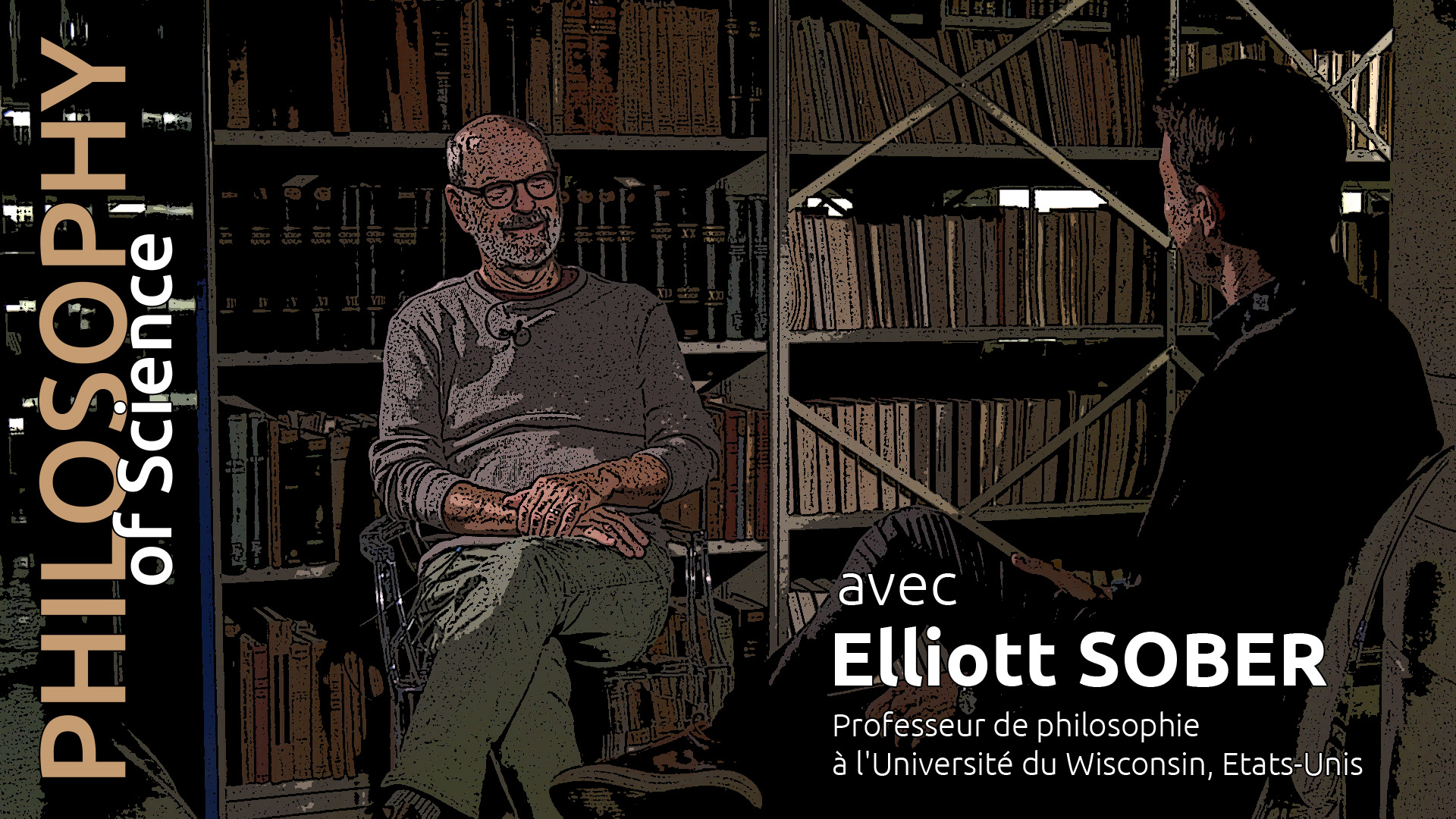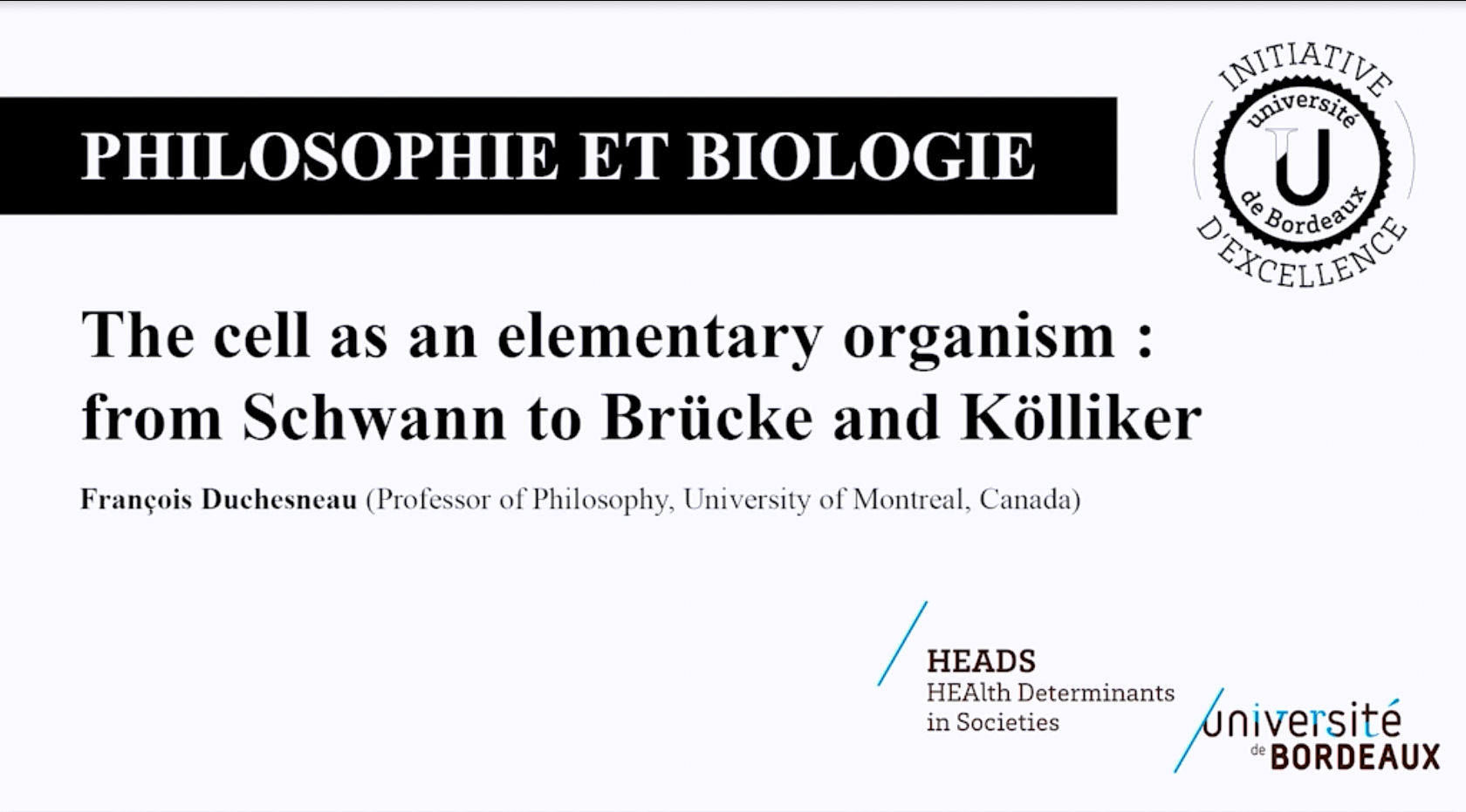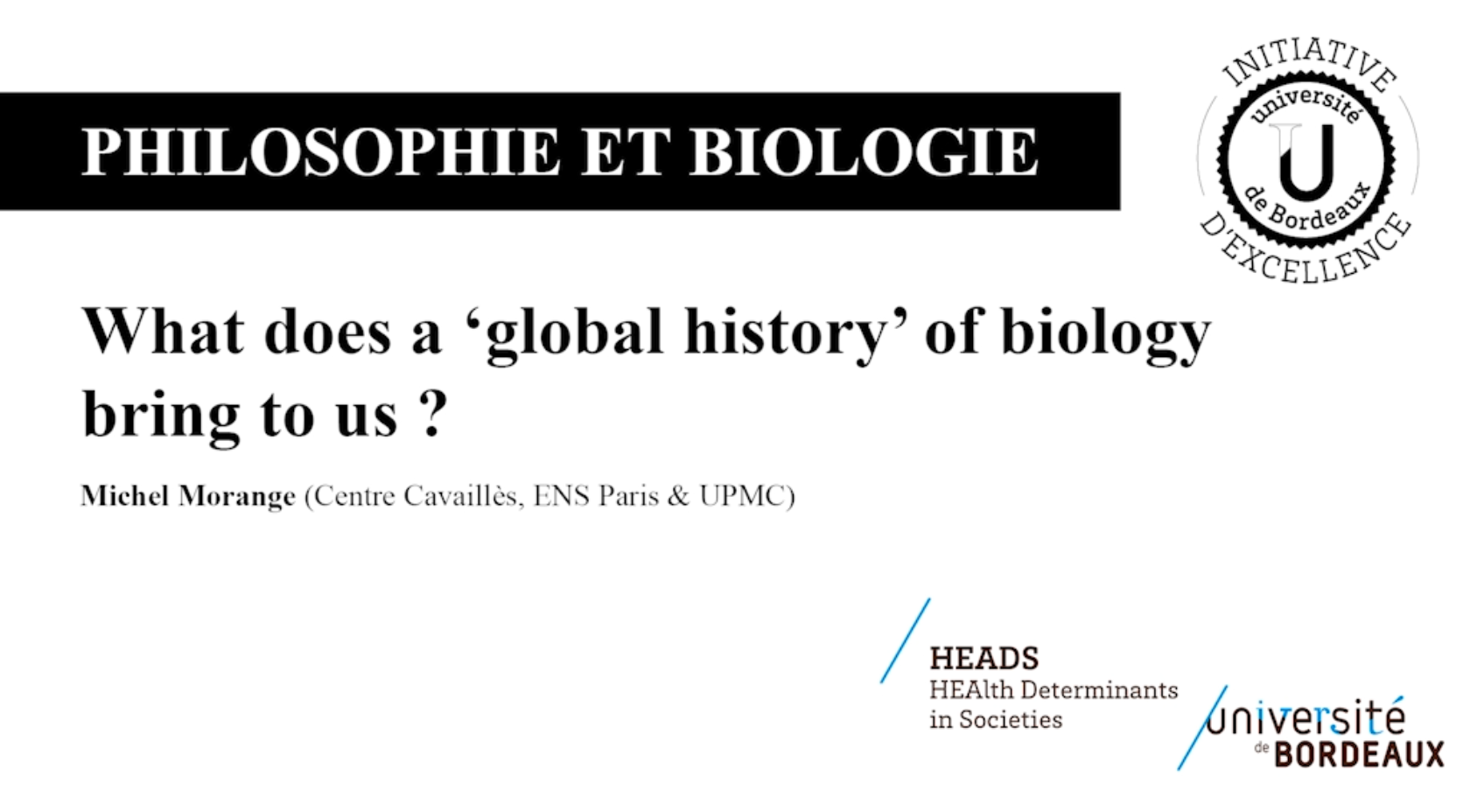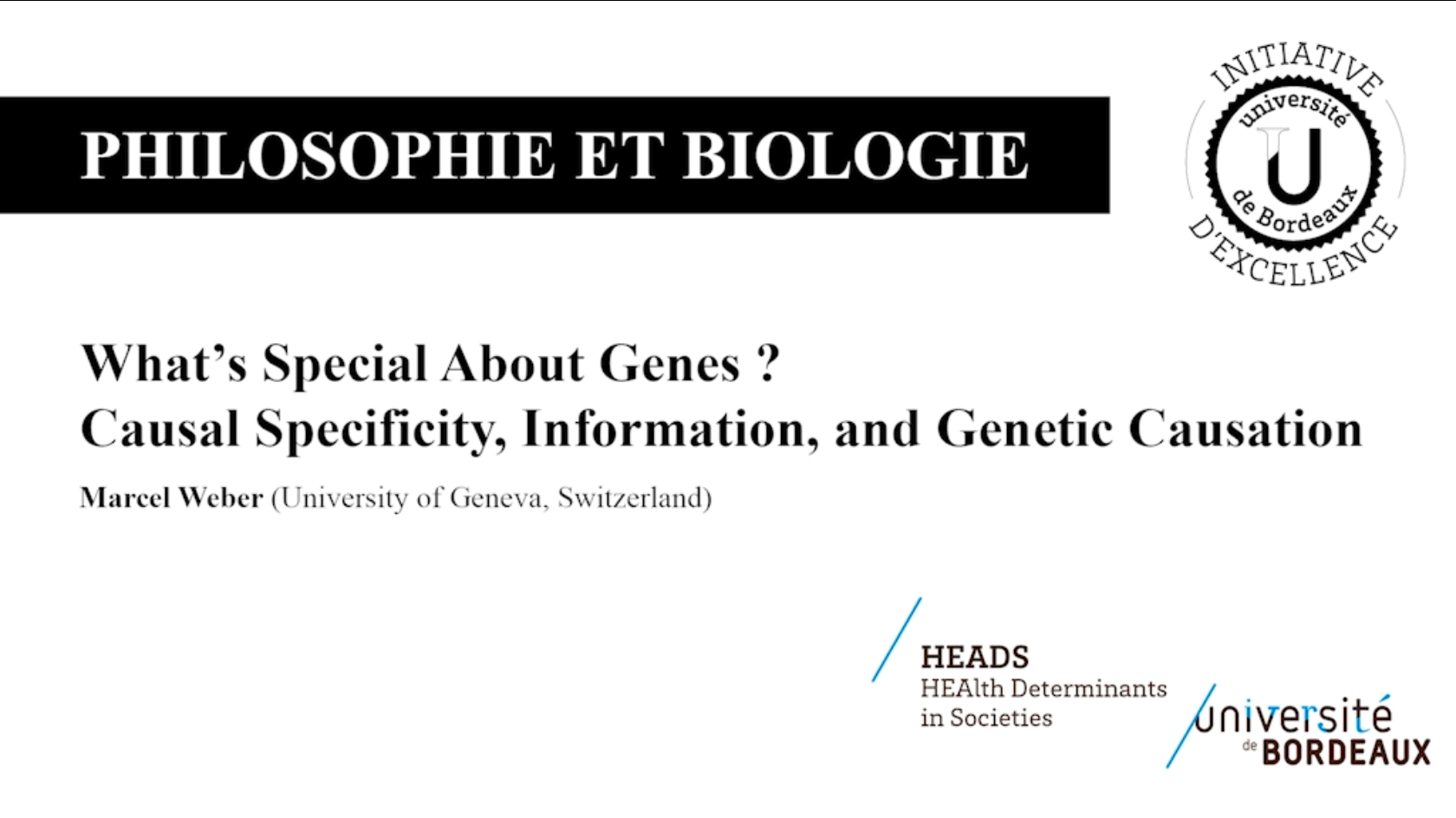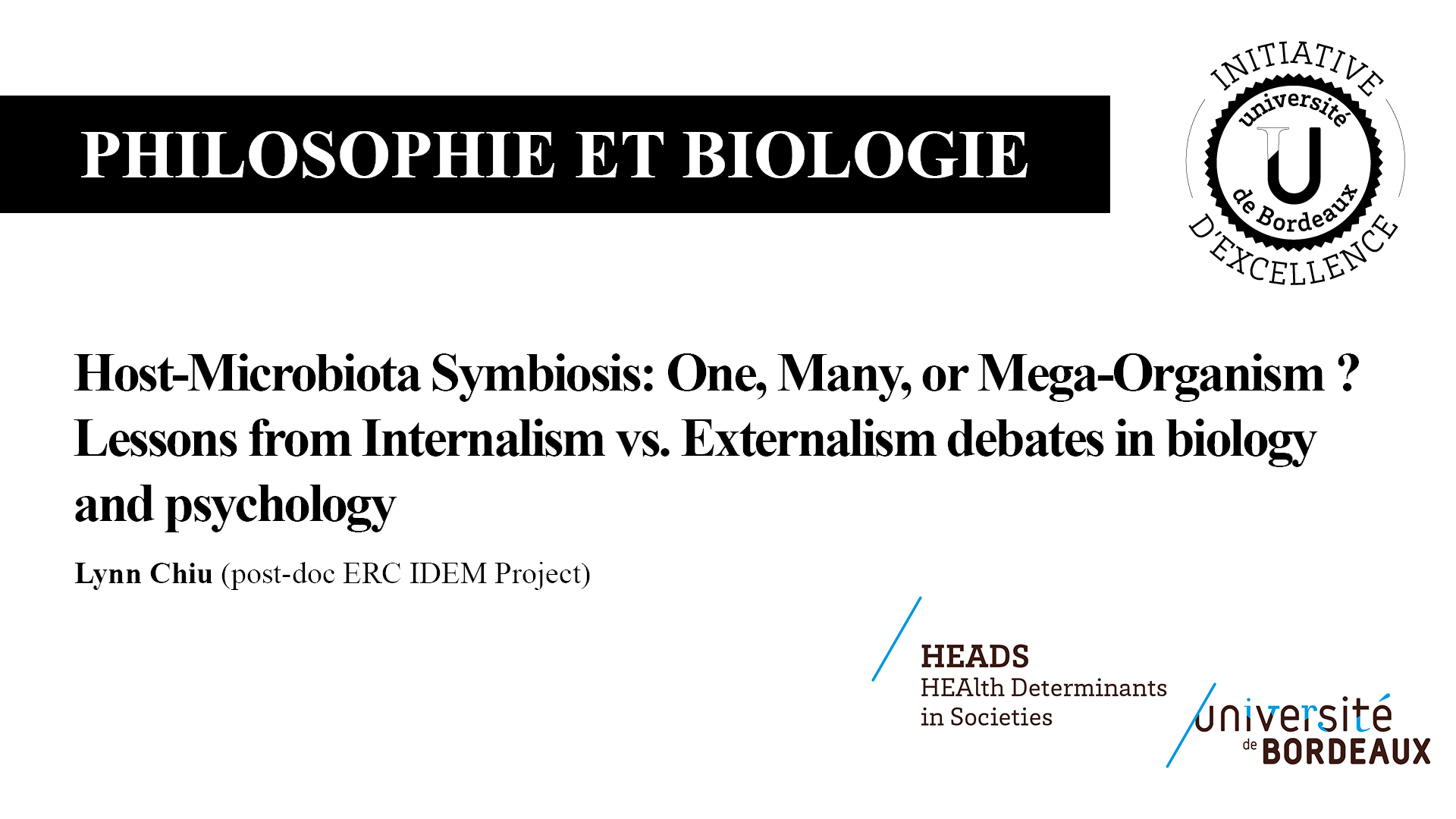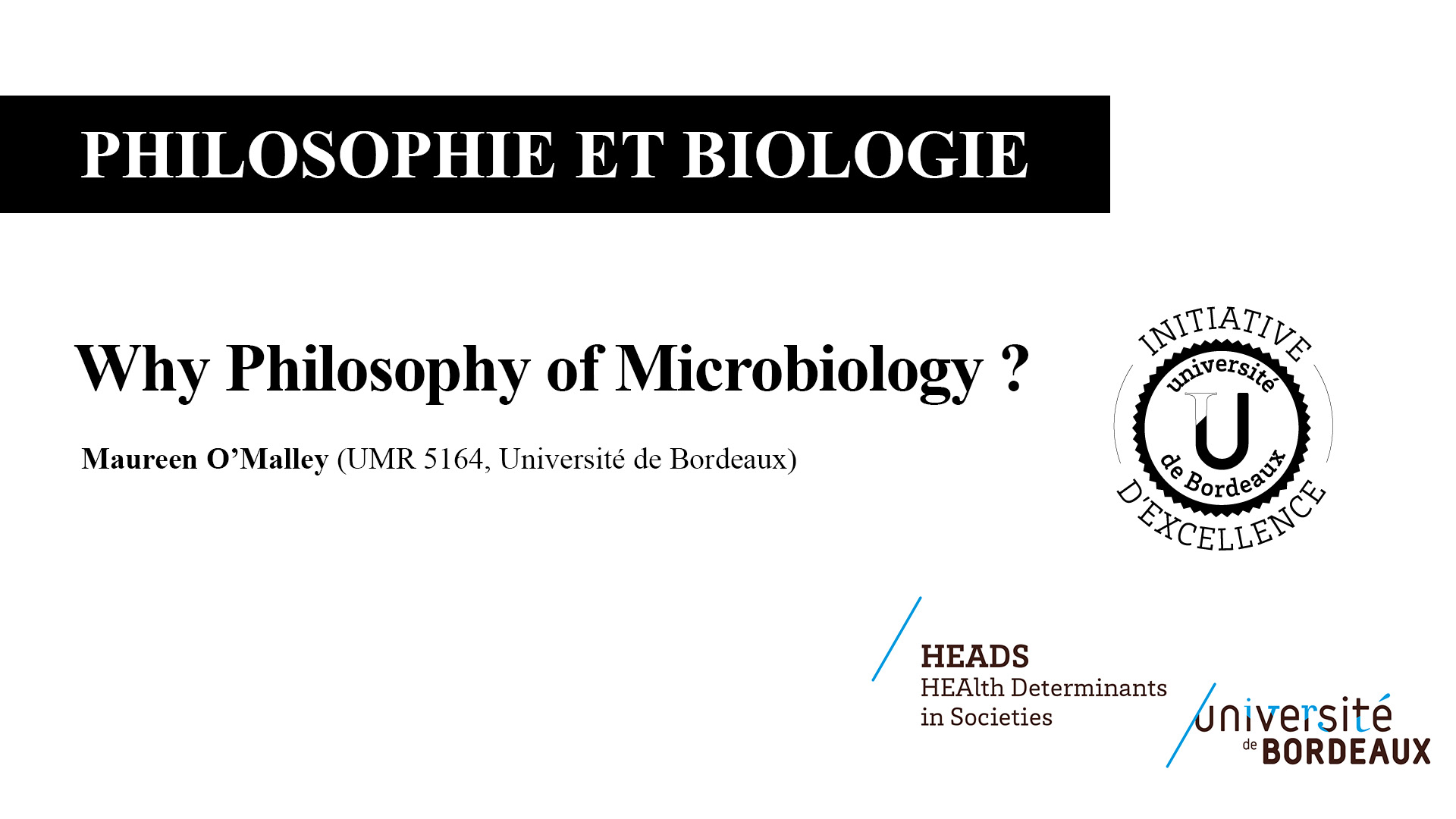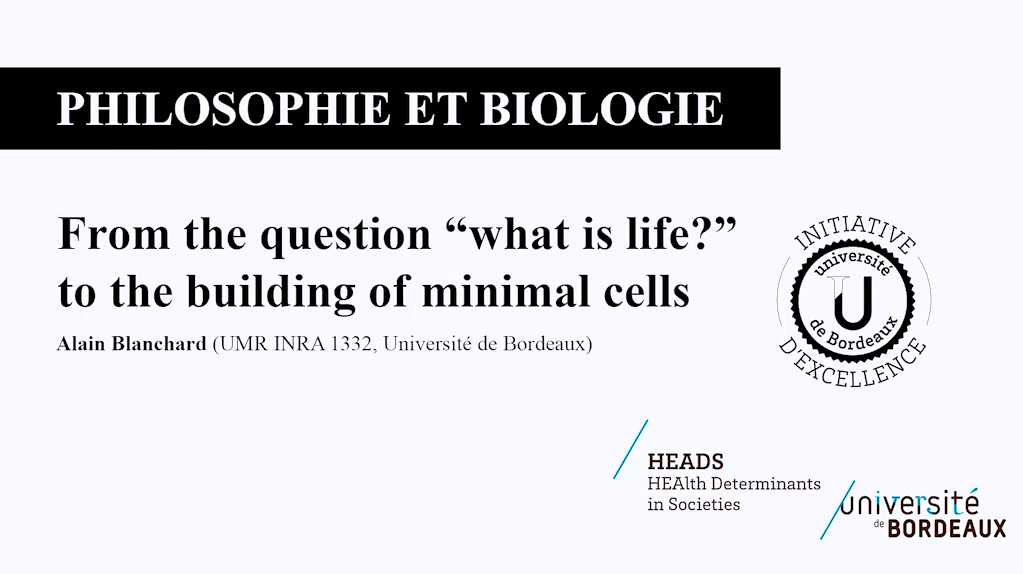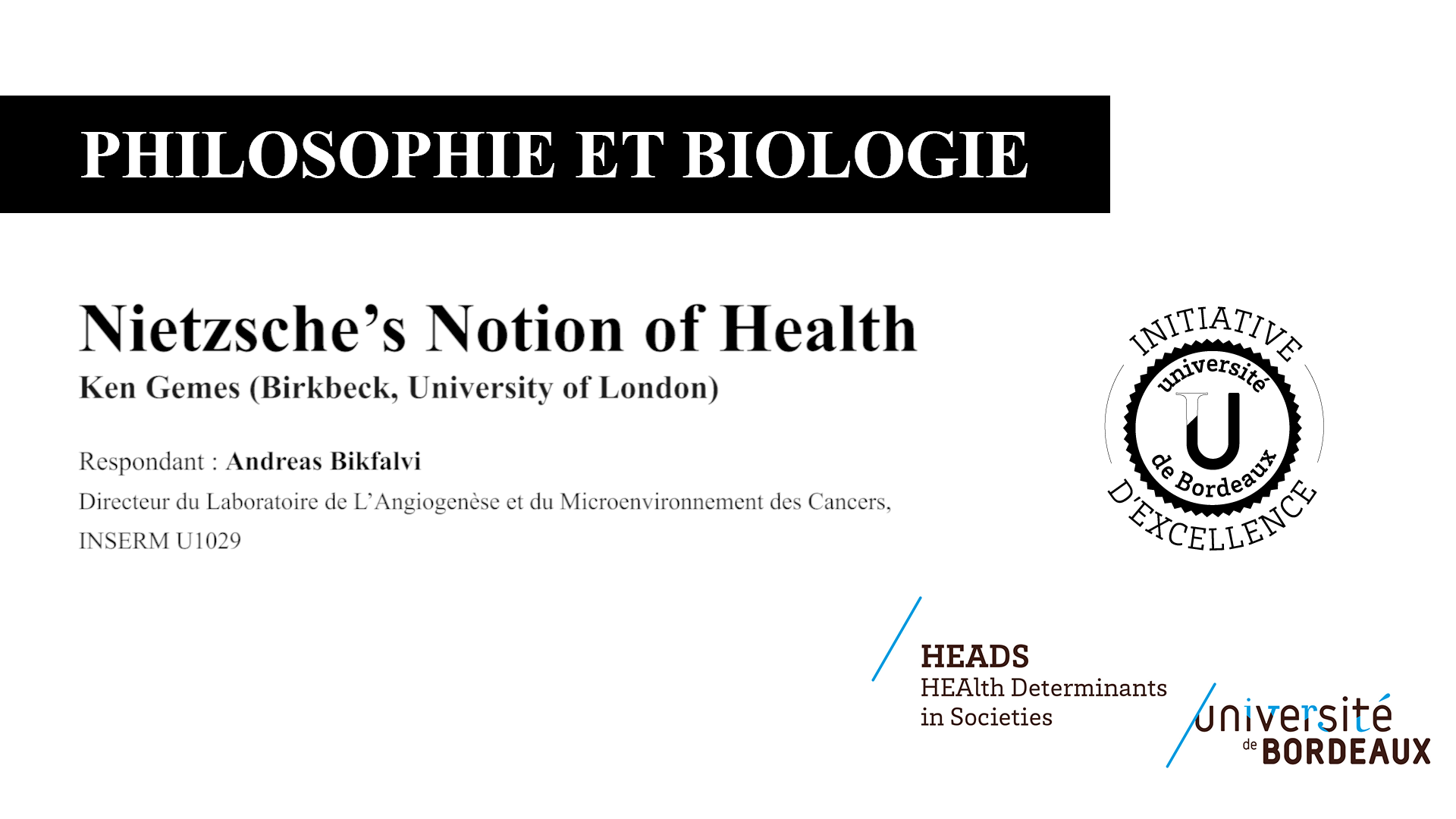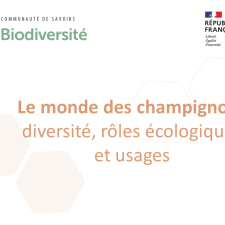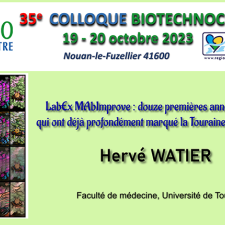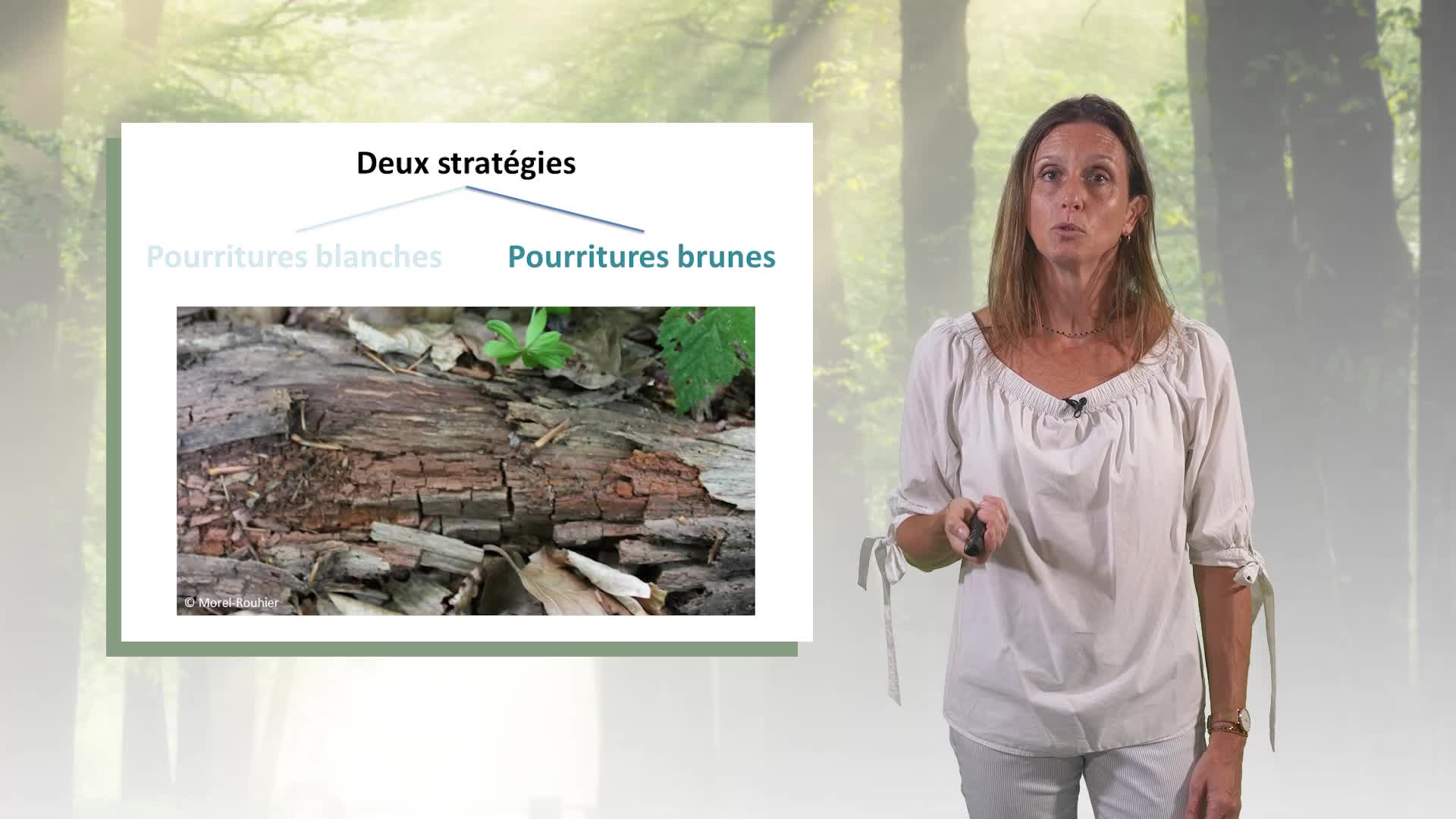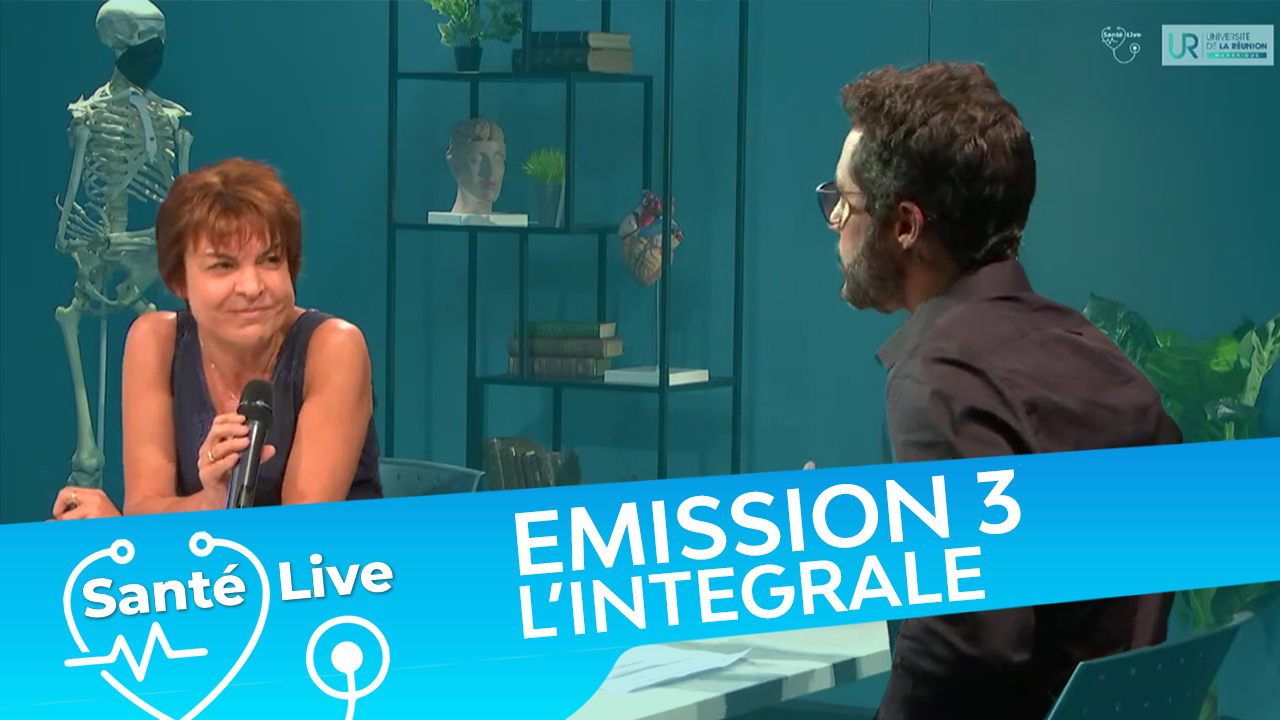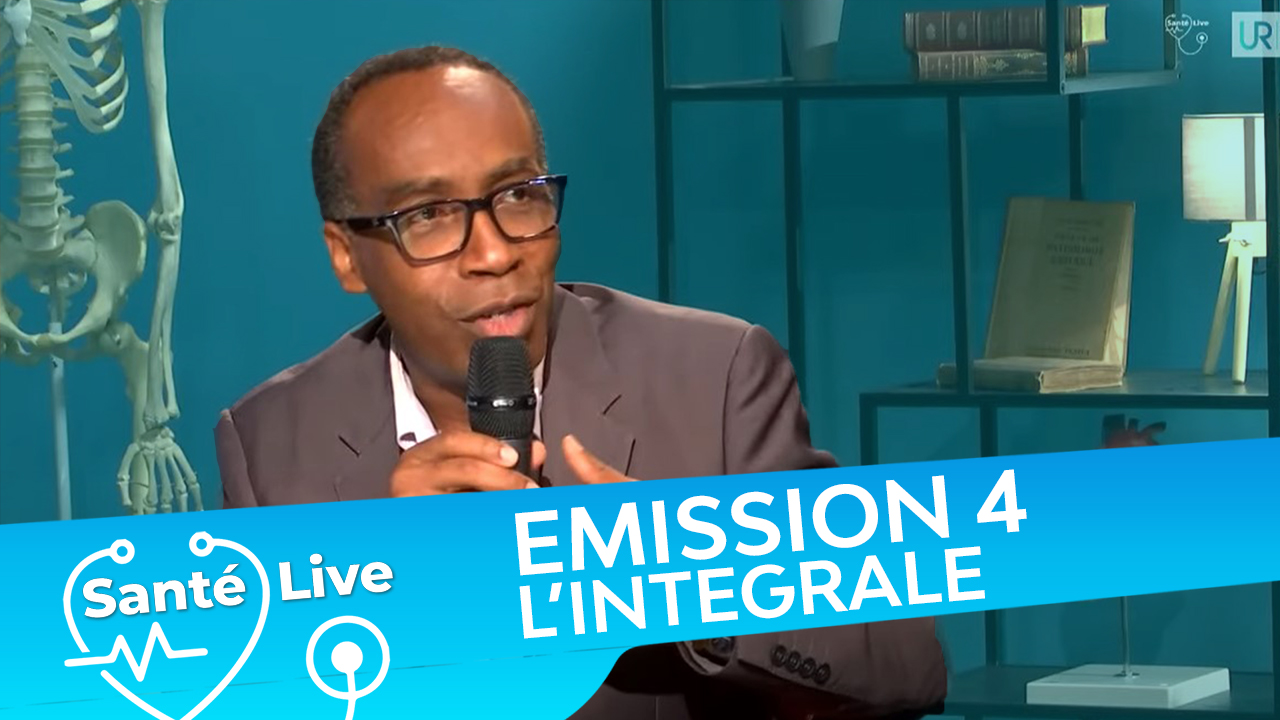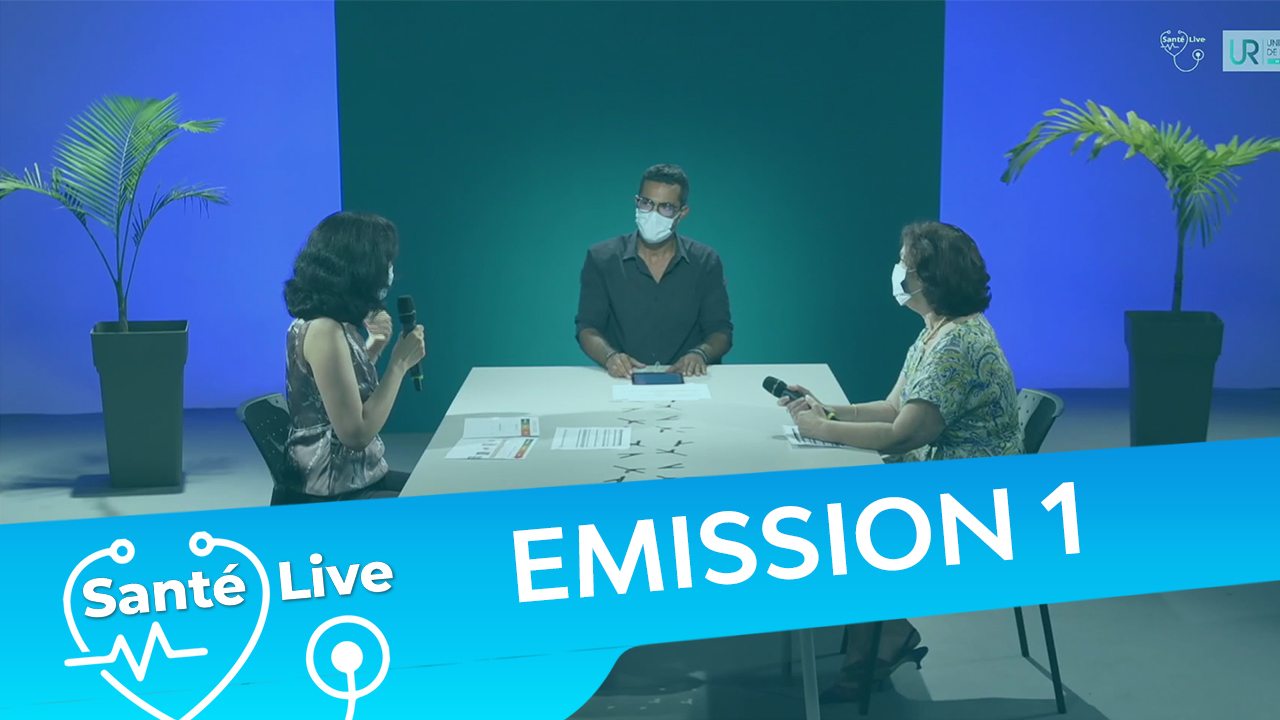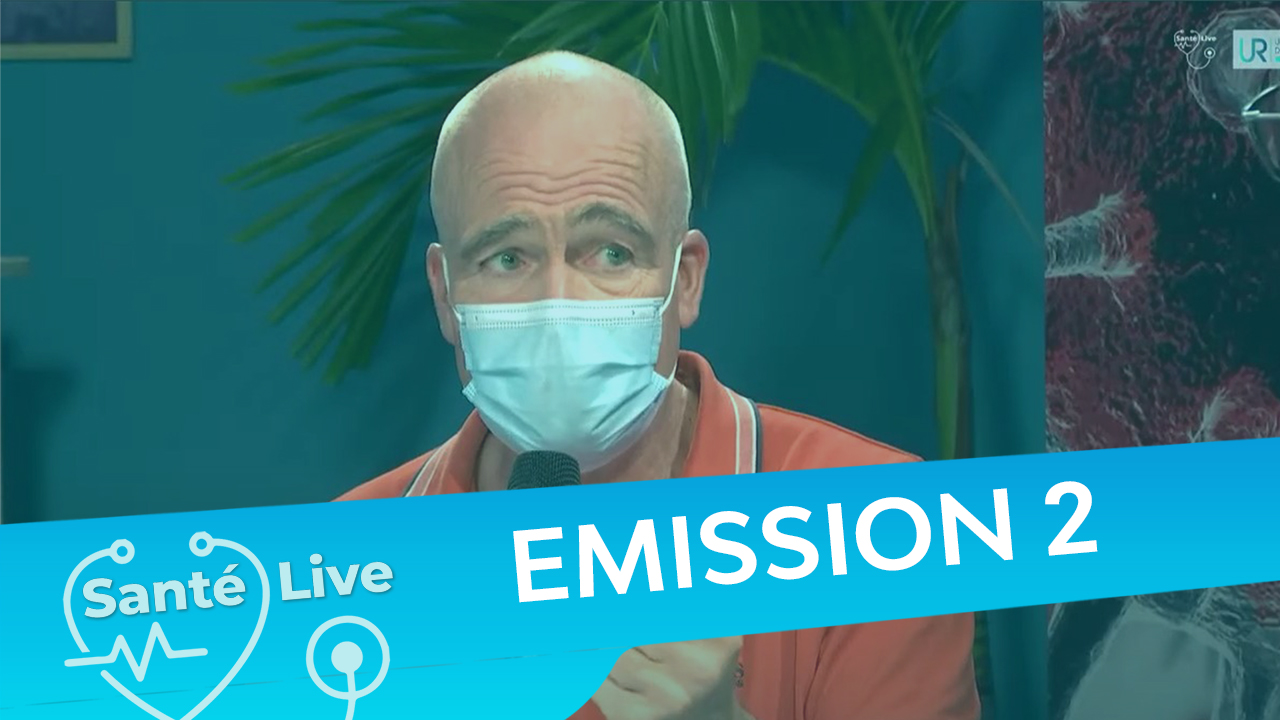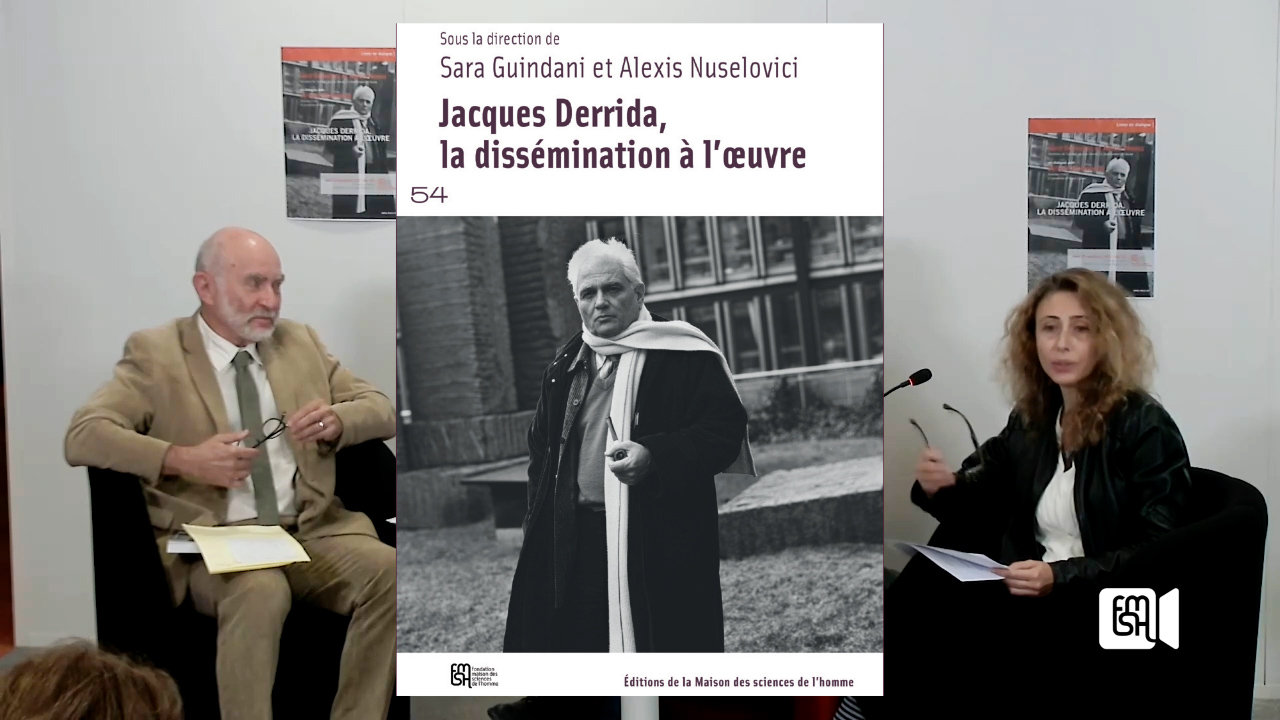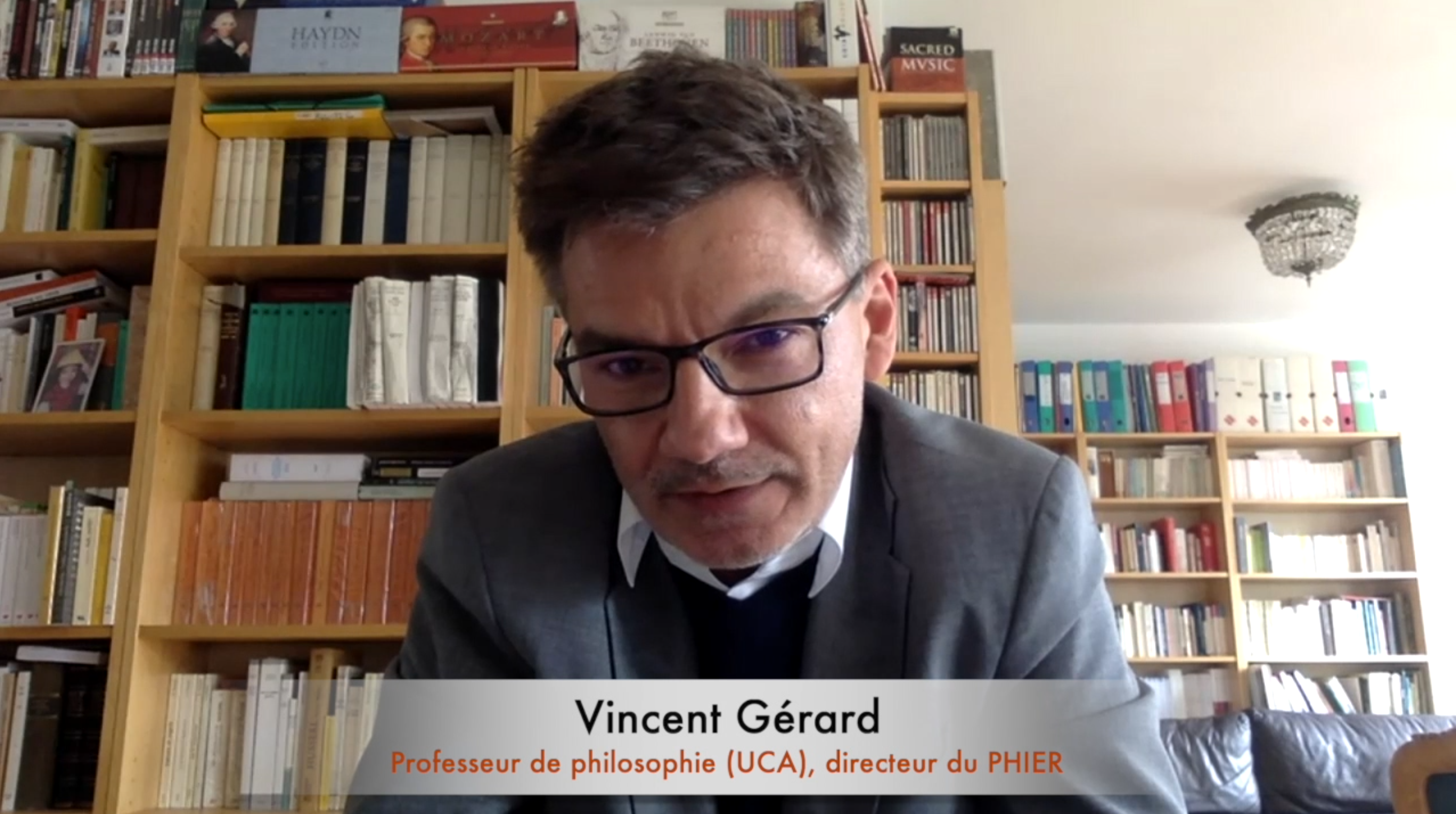Chapitres
- >> Thomas Pradeu : Presentation01'52"
- >> Sven Saupe : Self, identity, fungi01'49"
- Biology of Self00'55"
- Fungi position in living world01'35"
- Fungi meeting...00'45"
- Mutual aversion, Incompatibility02'01"
- Mecanistic description of the working of one specific incompatibility system04'22"
- Symbolically invested terms, metaphors...05'04"
- >> Mathieu Paoletti : Self and non-self in fungi00'20"
- The fungal cell cycle01'13"
- Non self recognition18'02"
- >> Jonathan Visentin: Vegetative incompatibility vs Organ transplantation00'45"
- La transplantation d'organes01'02"
- Similitudes entre HLA et Het-e02'14"
- Différences entre HLA et Het-e04'36"
- Discussion00'05"
- - Subjectivité et émotions dans la recherche scientifique02'14"
- - Metaphor problem, Sokal affair...05'48"
- - Het-e, HLA and self recognition02'19"
- - Existence of receptors involved in the recognition of pathogens ?00'30"
- - Evolution and selective pressure / what is the driver : immunity or histocompatibility 04'07"
- - Fungi involved in symbiosis ?01'23"
- - Tolerance mechanisms ?01'22"
- - Self and non-self : peut-on transposer le concept à la psychologie ?06'49"
- - Dissemination of the genes05'24"
Notice
Self and non-self in fungi
- document 1 document 2 document 3
- niveau 1 niveau 2 niveau 3
Descriptif
>> Sven Saupe : Self, identity, fungi
The notion of self is a rich but ambiguous concept that is used in a wide array of academic disciplines including immunology, psychology and philosophy (in particular in different branches of phenomenology). I would like to give an introduction to the application of this concept in the description of a cell-cell interaction phenomenon occurring in many if not all filamentous fungi and designated incompatibility. The term self non-self recognition is often used to classify this phenomenon thus stressing its likeness to other biological phenomena going under the same designation such as immune recognition or gamete recognition in plant allofertilization. After giving a direct description of incompatibility, I shall describe the molecular basis of a specific case of incompatibility mechanism involving a prion protein. Time permitting I would like to use the specific example of fungal incompatibility, to attempt to illustrate my impression of the role narration and symbolism (in the form of metaphors) play in the practice of research and textual rendition of scientific results.
>> Mathieu Paoletti : Self and non-self in fungi
Fungi are engaged in various biotic interactions requiring discrimination between self and nonhet loci defining incompatibility encode proteins displaying similarities with NOD Like Receptor (NLRs) of plant and animal innate immune systems. In the model species Podospora anserina genetic interactions between incompatible alleles of het-c and het-e mediate VI. het-e encodes a NLR protein while het-c codes for a glycolipid transfer protein. Evolutionary properties of these genes lead us to hypothesize that in addition to VI their products could function as fungal immune receptors following the guard model whereby HET-e recognizes alterations of HET-c as a consequence pathogen’s action. I will describe recently developed experimental models to assess HET-c and HET-e functions in detection of and response to hetero-specific non self. I will also briefly describe the huge repertoire of NLR encoded by fungal genomes that may be involved in non self recognition in different biotic interactions.
>> Jonathan Visentin : Vegetative incompatibility in fungi looks like graft rejection in human
Intervention / Responsable scientifique
Thème
Documentation
Ressources
Références bibliographiques
Daskalov A., Habenstein B., Martinez D., Debets A.J., Sabaté R., Loquet A. and Saupe S.J. (2015) : Signal transduction by a fungal NOD-like receptor based on propagation of a prion amyloid fold. PLoS Biol. Feb 11;13(2):e1002059
Paoletti M. and Saupe S.J. (2009) : Fungal incompatibility: evolutionary origin in pathogen defense? Bioessays 31(11) :1201-1210 (DOI : 10.1002/bies.200900085.)
Smith M., Bruhn J. and Anderson J. (1992) : The fungus Armillaria bulbosa is among the largest and oldest living organisms. Nature 356:428-431
En ligne
http://www.scientificamerican.com/article/strange-but-true-largest-organism-is-fungus/
Dans la même collection
-
Philosophy of Science / Elliott Sober
SoberElliottElliott Sober est philosophe de la biologie à l’Université du Wisconsin. Dans cette interview avec Thomas Pradeu, il récapitule son parcours et présente sa vision de la contribution de la
-
The cell as an elementary organism: from Schwann to Brücke and Kölliker
DuchesneauFrançoisThis presentation is about the way cell physiology (Cellular physiologie) was born. Indeed, Schwann invented the cell theory in 1839, but his views on the cell were rapidly challenged and transformed
-
What does a ‘global history’ of biology bring to us ?
MorangeMichelTo write a global history of life sciences from Antiquity to extant research, from molecular biology to ecology and ethology is an impossible task, the promise to be inaccurate and wrong in many
-
What’s Special About Genes? Causal Specificity, Information, and Genetic
WeberMarcelPhilosophers of biology have recently been debating to what extent such nucleic acids that are said to carry genetic information (i.e., DNA or mRNA) really play a special role in development. A
-
Host-Microbiota Symbiosis: One, Many, or Mega-Organism? Lessons from Internalism vs. Externalism de…
ChiuLynnI will distinguish between three types of interactionist reactions to internalist or externalist theories. These theories assign specific theoretical roles to internal and external factors,
-
Why Philosophy of Microbiology ?
O'MalleyMaureen A.Microbes have only recently become the objects of sustained philosophical attention. Some of the reasons why philosophers now find microbes and microbiology interesting, and why philosophy of
-
From the question “what is life?” to the building of minimal cells
BlanchardAlainDepuis plusieurs siècle, la question du sens et de la nature de la vie est un sujet central en philosophie et en sciences. Nous avons désormais rassemblé, au moyen d'une approche expérimentale, un
-
Nietzsche's notion of Health
GemesKenBikfalviAndreasIt is widely known that Nietzsche take himself to present a tremendous challenge to conventional morality. Many of his interpreters have been exorcised in trying to make precise the nature of that
Sur le même thème
-
Le monde des champignons : diversité, rôles écologiques et usages - CoSavez-vous ? Biodiversité
Les champignons jouent un rôle fondamental dans les écosystèmes et en agriculture. Ce webinaire met en lumière leur diversité et leur importance écologique, notamment dans leurs interactions avec les
-
LabEx MAbImprove : douze premières années d’existence qui ont déjà profondément marqué la Touraine …
WatierHervé35ème Colloque BioTechnoCentre 19-20 octobre 2023, la Ferme de Courcimont (Nouan le Fuzelier, 41600 F)
-
La dégradation du bois mort par les champignons
MorelMélanieMélanie Morel-Rouhier, professeure à l’université de Lorraine, explique dans cette vidéo comment certains champignons parviennent à dégrader le bois mort.
-
SANTE LIVE #5 - Le diabète
Émission présenté par Cédric PEDRE (Directeur de l'IREPS Réunion) Au programme de cette troisième émission Santé live -Les facteurs de risque -Le dépistage -La prévention Intervenants :
-
SANTE LIVE #3 - Maladies et tests génétiques
Émission par Cédric PEDRE (Directeur de l'IREPS Réunion) et Pr Bérénice DORAY, PU-PH Génétique, Vice-doyenne Recherche UFR Santé de l'Université de La Réunion, directrice du service Génétique du CHU.
-
SANTE LIVE #4 - Les vaccins
Présenté par Cédric Pedre directeur de l'IREPS Plus que jamais la vaccination est le sujet numéro un de santé publique. C'est pourquoi il est important d'en parler avec des spécialistes. Au
-
SANTE LIVE #1 - Du prédiabète au diabète
Bienvenue dans notre première émission consacrée au diabète, présenté par Cédric Pedre, directeur de l'IREPS Réunion. Le diabète est une maladie qui touche une grande partie de la population
-
SANTE LIVE #2 - La contraception
Cédric Pedre et le Professeur Von Theobald vous parle dans cette émission de contraception. Vous aurez dans cette émission des informations médicales sur les moyens de contraception, des surprises et
-
SOIRÉE DE PRÉSENTATION DE L'OUVRAGE "JACQUES DERRIDA, LA DISSÉMINATION A L’ŒUVRE"
BourmeauSylvainGuindaniSaraNuseloviciAlexisÀ l'occasion de la parution de l'ouvrage Jacques Derrida, la dissémination à l'œuvre dans la collection "54", les Éditions de la Maison des sciences de l'homme organisent une soirée de
-
Comment s’orienter dans la crise ?
Proposée et organisée par la Maison des Sciences de l'Homme de Clermont-Ferrand et le PHIER, laboratoire Philosophies et Rationalités, cette web conférence, ouverte à toutes et à tous, s’est tenue le
-
Le Libéralisme dans tous ses États : Histoire de la pensée
le Libéralisme dans tous ses Etats- Histoire de la pensée
-
Pourquoi philosopher sur le végétal ?
La place occupée par le végétal dans la pensée contemporaine n'a cessé de progresser ces dernières années. Les enseignements qui en découlent nous inviteraient à reconsidérer des notions telles


